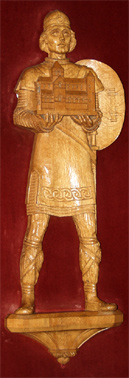About Rognvald
Founder of St Magnus Cathedral
Earl Rognvald Kali Kolsson seized power in Orkney in 1136. The resident earl had refused to share his earldom with Rognvald, which included Shetland, the North of Scotland and the Western Isles. Born c.1100 at his father's estate at Agder, Grimstad, Norway, the young Kali Kolsson (as he was then known) was the son of Kol Kalisson, a local chieftain, and Gunnhild Erlendsdottir, the sister of St Magnus. He was granted the title of Earl of Orkney from King Sigurd the Crusader of Norway, who also gave him the new name of Rognvald, after a previous Earl of Orkney. An early attempt at gaining power in Orkney failed, and it was only by trickery, intrigue and force that Rognvald found himself the sole ruler of the islands. He was to share his earldom with the young Harald Maddadsson for most of his reign, but Rognvald was very much the senior partner.
Rognvald was a charismatic figure, and it was during a visit to Norway
that he was persuaded to lead a pilgrimage to the Holy Land. In true Rognvald
style he had a magnificent ship built; carved, painted and inlaid with
gold. During his pilgrimage he wooed the beautiful Ermingerd, the Queen
of Narbonne in France, he laid siege to a castle in Galicia in Spain, and
in the Mediterranean he attacked a huge 'dromond'; a Saracen merchant ship,
which was ransacked for its valuables. He visited the holy shrines in Jerusalem
and bathed in the River Jordan before heading home overland, via Constantinople
and Rome. He faced a civil war on his return, as a third earl, Erlend Haraldsson,
had ousted Harald Maddadsson, but the two former earls united their forces
against Erlend and he was defeated in battle. Rognvald met his death in
Caithness on the 20th August 1158 when he was ambushed by a former friend,
who was by that time a bitter enemy. He was wounded on the chin by a sword
while riding up a steep and narrow path, and then driven through with a
spear. His body was buried in St Magnus Cathedral, where the Orkneyinga
Saga says many miracles was performed. He was canonised as a saint by Bishop
Bjarni, with the blessing of the Pope, in 1192. His remains still lie in
the cathedral, as well as those of his uncle, St Magnus.
After an unsuccessful attempt at seizing control of Orkney by force in
1135, Rognvald Kali Kolsson had to return back to his native Norway in
disgrace. His father, Kol Kalisson, said that the expedition had not
been a total failure as he had made friends with the people of Shetland.
From there he was able to launch an attack on Earl Paul the Silent in
Orkney in 1136. Before setting off Rognvald was advised by his father
to make a vow to his uncle, St Magnus, that if he was successful that
he would build a fine stone Minster in Kirkwall in his honour. After
managing to sabotage the warning beacon in Fair Isle, Rognvald's ship
arrived in Westray, while Earl Paul was stranded in Rousay due to adverse
weather and tides. While he was there Earl Paul was kidnapped by a local
chieftain called Svein Asleifsson, leaving the way clear for Rognvald
to claim the earldom. Once it was known that Paul would not be returning
the people of Orkney swore allegiance to Rognvald.
In 1137 work began on the building of St Magnus Cathedral, as Rognvald had vowed. The work went on well for the first three years, but then Rognvald ran out of money. The Orkneyinga Saga says that Rognvald offered the Orkney people the opportunity to buy back the land rights that they had lost to an earlier earl and become free landowners once more. They agreed, and soon there was enough money to continue the building work. Master masons who had been working on Durham Cathedral came to Orkney to take part in the building of St Magnus, while Rognvald's father, Kol Kalisson, supervised the work. The relics of St Magnus were taken there and placed in a shrine over the High Altar. Pilgrims came to pray at the shrine of St Magnus, but it never became a major cult centre. The apse that stood at the east end of the building was demolished in the early 13th century and a magnificent rose window was built. The west end was lengthened in the 15th century, so the cathedral as we see it now is a lot longer and higher than the one that Rognvald would have known. After his death Rognvald was buried in the cathedral, and he was made a saint in 1192. Both these saints' bones are still interred in the cathedral.
» More about St Magnus Cathedral

